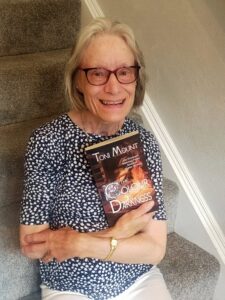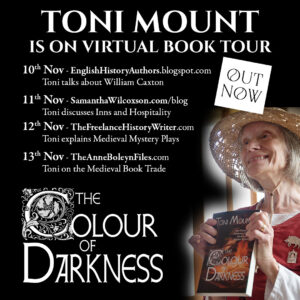 A warm welcome to historian and historical novelist Toni Mount, who’s joining us today as part of the book tour for her novel, The Colour of Darkness, the thirteenth Sebastian Foxley medieval murder mystery. Toni is sharing this article on the book trade in late medieval London…
A warm welcome to historian and historical novelist Toni Mount, who’s joining us today as part of the book tour for her novel, The Colour of Darkness, the thirteenth Sebastian Foxley medieval murder mystery. Toni is sharing this article on the book trade in late medieval London…
When we think about medieval London, we probably imagine grimy streets, plague and maybe a knight or two clanking through the city. But tucked within the chaos was a quiet revolution – one involving paper, ink and a growing thirst for knowledge. By the late 1400s, the book trade in London wasn’t just alive; it was thriving. And at the heart of it all stood St Paul’s Cathedral – not just a place of worship, but a book-fest for the city’s literate elite.
To put this in context, the printing press arrived in England when William Caxton famously set up the first one at Westminster in 1476 and the world of books was changing fast. Previously, books were hand-copied by scribes – as at the fictional Seb Foxley’s workshop in Paternoster Row, just north of St Paul’s, in my latest novel, The Colour of Darkness. Writing every page by hand meant they were expensive and slow to produce. But then came the printing press – a real game-changer.
Printing took a decade or two to catch on in England, mainly because it was a tricky procedure to master – but once the techniques were established books could be produced faster and cheaper. More books available led to an increase in literacy, especially among the urban middle classes, clergy and educated elite. London, with its bustling population and growing trade networks, became a prime spot for this new business.
St Paul’s Cathedral: The Book Trade’s Beating Heart
Forget the grand white dome you see today in the City of London because that was designed by Sir Christopher Wren after the Great Fire of 1666. Before that catastrophe, it was ‘Old St Paul’s’, a massive gothic structure that dominated the skyline with a spire over 400 feet tall, at least until it was struck by lightning in the reign of Elizabeth I. Its precinct and churchyard weren’t just for prayer and pigeons but, together with nearby Paternoster Row, were at the very centre of London’s book trade. In fact, Paternoster Row remained at the heart of the British publishing industry until it was destroyed by bombs during World War II.

Why did St Paul’s become such a hive of book-production? The cathedral’s proximity to learning helped. The Cathedral School and other educational institutions were nearby, including the Inns of Court to the west of the city where lawyers were trained and the sons of the aristocracy were schooled in the arts required for life at the royal court. The clergy needed books for sermons, study and teaching, so local demand was ensured.
Who were the Printers?
By the 1480s, London had a small but important group of professional printers. William Caxton deserves the spotlight since he was the first to introduce a press, having learned the business in Burgundy and the Low Countries. His press in Westminster produced some of the first books in English, making literature and religious texts more accessible to the public. After Caxton, his former assistant, Wynkyn de Worde, took over the operation and moved it closer to the action, by St Paul’s. De Worde knew the churchyard was where the customers would come. He printed everything from devotional tracts to almanacs and even the occasional romance or how-to guide. He’s sometimes credited with being one of the first to market printed books to a wider audience.
But printers, like the scribes before them, didn’t only create the pages. They often collated and stitched the pages before either binding them or passing them on to a specialist binder to stitch the pages into a cover. A book’s binding could range from simple stitched parchment to elaborately tooled leather with jewelled clasps. The wealthy might commission personalised bindings with their family crests. The printers often dealt with sales too or went into partnership with independent booksellers. These sellers might have a permanent stall near St Paul’s or be mobile, setting up shop at fairs or markets – wherever there were customers.
What was on the shelves?
So what were Londoners reading? A lot of religious texts, unsurprisingly: sermons, Books of Hours, Psalters and the lives of popular saints. The Church was a dominant force in everyday life and owning religious books was a sign of piety and status. For this reason, the new fashion of portrait painting would frequently show the sitter with a religious book in their hands. But secular works were creeping in, too. Translations of classical texts, histories, medical manuals and even cookbooks began to appear. One popular genre was that of ‘books of courtesy’ – guides to correct behaviour, speech and etiquette for the aspiring gentleman or gentlewoman. There were also the early English romances and poetry. Caxton and de Worde printed tales of King Arthur, Chaucer’s Canterbury Tales and other stories that helped shape English literary culture down to our own times.
Not only Men’s work
While the big names in printing were all men, there is increasing evidence that women played a quiet but important role in the trade. Widows who took over their husbands’ businesses often became successful printers or booksellers in their own right. The trade was one area in medieval commerce where women participated openly, though their contributions often went under-recorded.
Censorship and Control
Of course, not everyone was thrilled about the explosion of printed material. The Church and the Crown kept a watchful eye on the presses. Unauthorised texts, especially those seen as heretical or politically subversive – such as the Ars Notoria in The Colour of Darkness – could get a printer, stationer or book seller into trouble. The Stationers’ Company, officially incorporated in 1557 but already in existence in the fifteenth century to oversee the production of hand-written books, would help regulate who could print what when printing eventually came under its umbrella.
By the early 1500s, the London book trade was setting the stage for what would become a publishing powerhouse in later centuries. It was local but also international, connected by trade routes that brought in books and ideas from France, the Low Countries and beyond. Some of the early printers, like Wynkyn de Worde, brought their foreign know-how to the new trade. The stalls around St Paul’s would continue to be a hub for centuries, long after the old cathedral itself was gone. In fact, it’s reckoned that one reason why the building burned so ferociously during the Great Fire of 1666 was that the printers and stationers stored their stocks of paper and books in St Faith’s Chapel in the cathedral’s undercroft – a disaster just waiting to happen.
The people who browsed there – the scholars, preachers, merchants, citizens and maybe a curious apprentice or two – were part of a quiet revolution, one that transformed how knowledge spread and who had access to it.
So next time you think about medieval London, picture not just mud and markets but a vibrant little world of booksellers shouting above the crowd, customers thumbing through the latest printed pamphlets and the great gothic walls of St Paul’s towering above it all. The presses may have been small but their impact was monumental.
My new Sebastian Foxley novel, The Colour of Darkness, transports readers to midsummer 1480, in medieval London where our hero has to solve a number of serious crimes, involving Master Caxton’s printing business, ‘suspect’ books and witchcraft. London is ready for a joyous festivity but, for some, there is nothing to celebrate when Death stalks the city’s sweltering streets. As livelihoods are brought to ruin and trust withers in the heat, our hero and artist-cum-sleuth discovers trouble has come to his own doorstep. Plague rears its hideous head; fire, theft and disease imperil the citizens.
Meanwhile, a beautiful young woman enchants the men of London and the mob shrieks that witchcraft is to blame when waxen dolls, spiked with pins, are discovered. With such horrors in his possession and discovering that guilt lies too close at hand, can Seb unravel the mysteries and save those he loves before it’s too late?
Join Seb Foxley in this intriguing and danger-riddled new adventure, The Colour of Darkness, out now from MadeGlobal.
The Colour of Darkness by Toni Mount
 The Thirteenth Sebastian Foxley Medieval Murder Mystery
The Thirteenth Sebastian Foxley Medieval Murder Mystery
ISBN: 978-8412971620
366 Pages
Available in Paperback and Kindle E-book
Order the book: https://mybook.to/colour_of_darkness
Midsummer in medieval London should be a time of revelry, but for many, there is nothing to celebrate. Death stalks the sweltering streets as plague raises its hideous head, livelihoods crumble, and trust wilts in the heat. Fire, theft, and murder loom over the city, and once again, artist and reluctant sleuth Sebastian Foxley finds danger perilously close to home.
When a beautiful young woman enchants the men of London, suspicion soon follows. The discovery of waxen dolls spiked with pins sends the city into a frenzy, convinced that witchcraft is to blame. With dark secrets lurking too near for comfort, Sebastian must unravel a tangled web of deceit and suspicion. Can he uncover the truth and protect those he loves before it’s too late?
Join Sebastian Foxley for another richly woven medieval mystery where peril lurks behind every shadow and the colour of darkness hides deadly truths.
Reviews
The level of detail evokes a clear and crisp vision of life in medieval England. The familiar characters continue their lives while Sebastian investigates a case of arson and theft and an accusation of witchcraft. The plot is smoothly told and unfolds in a natural progression. I think this is one of Mount’s best, a delight to read with a satisfying finish. – DIANE
I love the details of day-to-day goings on in the Foxley household that can give us a better idea of what medieval folk ate for meals for example, dressed in, how they planned their daily lives and how they interacted with each other. On top of that add some interesting new characters (is she or isn’t she; will he or won’t he?), some endearing old characters and some fascinating mysteries that only our Seb can solve, and you have another enthralling and enchanting read. Thanks Toni! – CAROLYN C.
Another brilliant book about seb foxley and family . Every detail brings you into seb foxley ‘s life and work with beautiful descriptions of his illustrations. There is more crime for seb to delve into. I read this in one sitting , didn’t want to put it down. Enjoy ! – MAUREEN HAGAN
Catch up with any book tour stops you missed:
